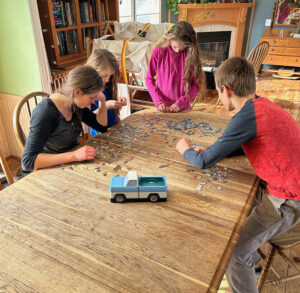 Editor’s Note: This post is from Jacqueline Franks, the brains behind deeprootsathome.com, a website devoted to practical homesteading and self-sufficiency. We’re pleased to have her back on board as a contributor to Country Life.
Editor’s Note: This post is from Jacqueline Franks, the brains behind deeprootsathome.com, a website devoted to practical homesteading and self-sufficiency. We’re pleased to have her back on board as a contributor to Country Life.
Most people imagine a vegetable garden as a spot that bakes in the sun all day. Now that is ideal for some vegetables such as tomatoes, peppers, and squash. These plants work hard to produce succulent fruit, large leaves, and sprawling vines, and need water, ample sunlight, and nutrients to grow.
But what if you want to grow vegetables but don’t have a site like this “ideal†one where you live? Rest assured, there are plenty of vegetables that will grow well without full sun, so for those who have some shade, you can grow vegetables, too.
Leafy vegetables require less sun because they don’t develop fruit or vines. These plants actually prefer cool temperatures and become bitter or develop seed heads (this is called bolting) when temperatures soar. Leafy vegetables grow well in partial shade, especially in hot climates.
From all I understand, there is no vegetable that will grow in full, dense shade or where they have to compete with tree roots. The following LEAFY vegetables will produce with four to six hours of sun per day, or fairly constant light dappled shade:
- SALAD GREENSÂ such as leaf lettuce, arugula, endive, cilantro, spinach: I plant to the east of taller tomatoes or peppers. Some leaves that get more sun are slightly bleached in July/Aug, but I was able to harvest leafy veggies all summer.
- Broccoli
- Cauliflower
- Brussels Sprouts
- Swiss Chard
- Leafy Greens, such as collards, mustard greens, spinach, and kale
 ROOT vegetables need more sun than leafy vegetables, usually about six or more hours of sun daily. Green beans, peas, and cabbages would also fall into this category.
ROOT vegetables need more sun than leafy vegetables, usually about six or more hours of sun daily. Green beans, peas, and cabbages would also fall into this category.
Some herbs are actually quite shade-tolerant. Members of the mint family fare particularly well, according to the University of Missouri website. Other herbs for shade include basil, sage, parsley, chives, coriander and tarragon.
A good idea is to observe your proposed site through out the day and mark the limits of the shadows cast. It will also vary during the different times of the year as the sun sits higher or lower in the sky. A well-situated tree to the west of your garden can cast a cooling shadow after 3 or 4 PM in the hottest part of the summer. It might save water and extending the productive season for these veggies. Plan your garden well away from walnut trees. Walnuts produce iodine which will stunt or kill vegetables and perennials.
 If you’re blessed to have an area with full sun that you can reserve for a vegetable garden, knowing which plants will take some shade will help you get the most out of that plot. You can use that sunny space to grow only the sun-lovers: peppers, tomatoes, eggplants, tomatillos, corn, strawberries, rhubarb, potatoes, squashes and more.
If you’re blessed to have an area with full sun that you can reserve for a vegetable garden, knowing which plants will take some shade will help you get the most out of that plot. You can use that sunny space to grow only the sun-lovers: peppers, tomatoes, eggplants, tomatillos, corn, strawberries, rhubarb, potatoes, squashes and more.
The other crops, those that do well in the shade, can be tucked in anywhere. A trick I use in intensive gardening is to plant lettuces and spinach to the east of a taller, more sun-loving plant such as okra or peppers or tomatoes, and thus they are shaded in the heat of the day.
 Consider growing some lettuce or radishes in a container or window box that only gets sun half the day. Window boxes are also ideal for herbs. Make use of the space you have, in both sun and shade, and you can increase the amount of vegetables you can harvest.
Consider growing some lettuce or radishes in a container or window box that only gets sun half the day. Window boxes are also ideal for herbs. Make use of the space you have, in both sun and shade, and you can increase the amount of vegetables you can harvest.
Having a partly-shady yard doesn’t mean you’re destined to go through the summer minus fresh garden vegetables. By making the most of what you have, you can harvest lettuces, peas, and other tasty, shade tolerant veggies from spring through fall.
































